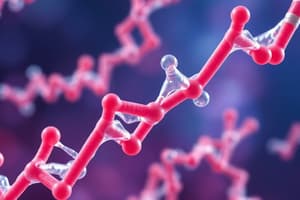Podcast
Questions and Answers
What are enzymes?
What are enzymes?
- Protein catalysts (correct)
- Nucleic acid catalysts
- Carbohydrate catalysts
- Lipid catalysts
What is the folded shape of a protein chain that gives it its function?
What is the folded shape of a protein chain that gives it its function?
- Primary structure
- Secondary structure
- Tertiary structure (correct)
- Quaternary structure
What are the chemicals involved in a reaction that temporarily combine with enzymes?
What are the chemicals involved in a reaction that temporarily combine with enzymes?
- Substrates (correct)
- Coenzymes
- Inhibitors
- Activators
What is the part of the enzyme where the substrate binds called?
What is the part of the enzyme where the substrate binds called?
According to the lock and key model, why are enzymes highly specific to their substrates?
According to the lock and key model, why are enzymes highly specific to their substrates?
What term is used for the combination of an enzyme and a substrate?
What term is used for the combination of an enzyme and a substrate?
Why are enzymes considered biological catalysts?
Why are enzymes considered biological catalysts?
In the induced fit model, why do enzymes change shape upon binding to their substrates?
In the induced fit model, why do enzymes change shape upon binding to their substrates?
What characteristic makes enzymes unique compared to other catalysts?
What characteristic makes enzymes unique compared to other catalysts?
What determines an enzyme's ability to bind with a substrate?
What determines an enzyme's ability to bind with a substrate?
Flashcards are hidden until you start studying
Study Notes
Enzymes
- Enzymes are protein catalysts that speed up chemical reactions necessary for life.
- Enzymes are a type of protein, made up of a long chain of amino acids.
- The amino acid chain is folded into a precise shape, giving the protein its function.
Enzyme Action
- Enzymes temporarily combine with the chemicals involved in a reaction, known as the substrate.
- The combination of enzyme and substrate is called the enzyme-substrate complex.
- When the enzyme and substrate combine, the substrate is changed to a different chemical, called the product.
- The enzyme is not consumed or altered by the reaction.
Lock & Key Model
- The part of the enzyme where the substrate binds is called the active site.
- Enzymes are highly specific and will only bind one type of substrate.
- The lock and key model suggests that the enzyme and substrate have specific complementary geometric shapes that fit exactly into one another.
Induced Fit Model
- The induced fit model is an alternative to the lock and key model, suggesting that the enzyme's active site changes shape to fit the substrate.
Studying That Suits You
Use AI to generate personalized quizzes and flashcards to suit your learning preferences.





